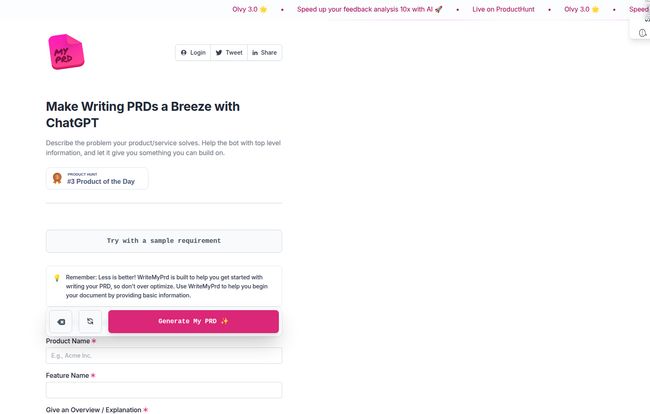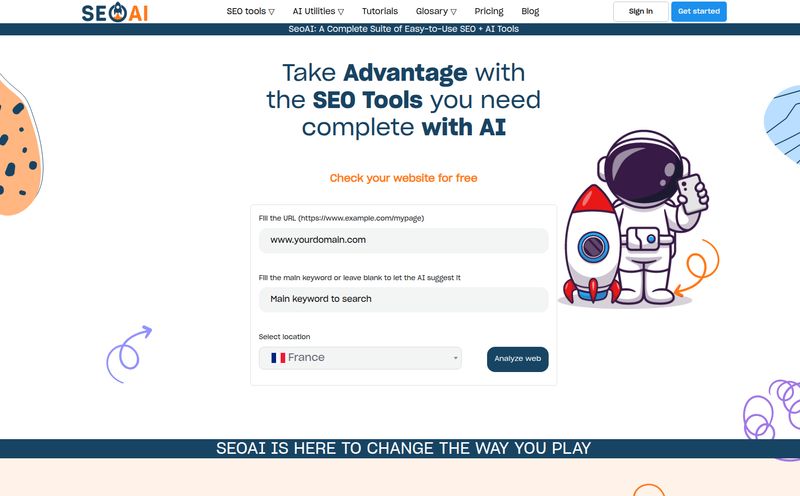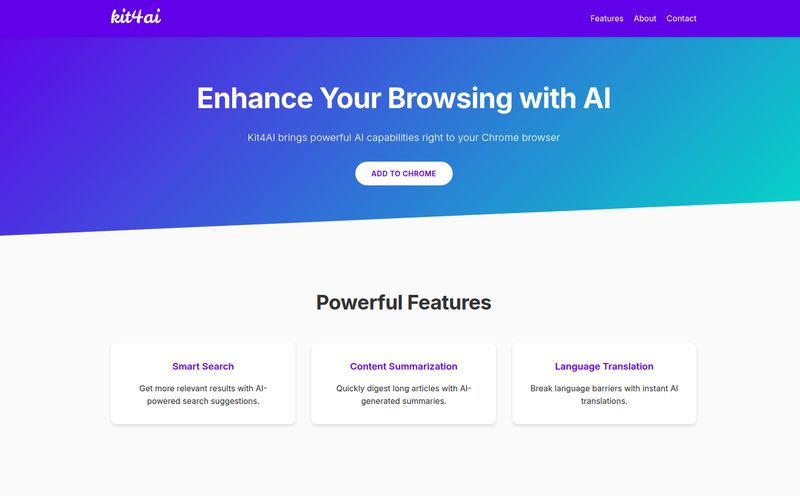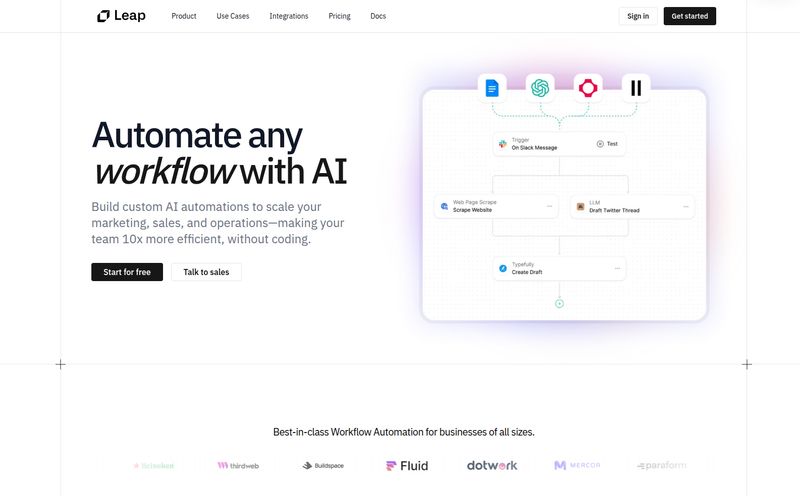We’ve all been there. It’s Monday morning, the coffee is just starting to kick in, and you’ve got a blinking cursor on a blank document titled “New Feature PRD_v1_final_final_for_real_this_time.docx”. The pressure is on. Engineering needs specs, design is waiting for direction, and you... well, you’re just trying to remember what you all agreed on in that meeting last Thursday.
Writing a Product Requirements Document (PRD) can feel like a chore. It’s part art, part science, and all-consuming. For years, I’ve relied on a mix of old templates, sheer willpower, and copious amounts of caffeine to get the job done. But lately, I’ve been playing with a new tool that’s been a genuine game-changer for that initial, painful drafting phase. It’s called WriteMyPrd, and it’s like having a hyper-caffeinated junior PM on tap, ready to spitball ideas with you.
So, What is WriteMyPrd Anyway?
In short, WriteMyPrd is a slick, simple tool that uses the magic of GPT-3 (the same brain behind ChatGPT) to generate a first draft of your PRD. You feed it some basic information—the high-level stuff you already have floating around in your head or in your Slack DMs—and it gives you a structured document to build on. It’s not meant to write the entire thing for you, and that's an important distinction. Think of it less as a self-driving car and more as a really, really good cruise control system. It gets you going and keeps the momentum, but you still need to steer.

Visit WriteMyPrd
The whole premise is to make writing PRDs, as their homepage says, “a breeze.” And honestly? After the last few weeks of using it, I can say it really does lower that initial barrier to entry.
Getting Started: A Quick Walkthrough
The user interface is refreshingly simple. There are no crazy sign-up processes or 20-minute tutorials. You land on the page, and the form is right there. It asks for the basics:
- Product Name: What's your product called?
- Feature Name: What's the specific thing you're building?
- Overview / Explanation: Here’s where you do a little brain dump. What’s the goal? Who is it for? Why are we building this now?
- Define Your Requirement (Feature list): Just a list of the core features or user stories you have in mind. Don't overthink it.
- User Feedback: This is a great touch. You can paste in direct quotes or summaries of what users have been asking for.
Once you fill that out, you hit “Generate My PRD,” and the AI elves get to work. In under a minute, you have a draft. A real, structured draft with sections for background, goals, user stories, and success metrics. It’s pretty wild.
The Good, The Bad, and The AI-Generated
Like any tool, especially an AI one, it’s not perfect. It has its strengths and its... quirks. I've been in the SEO and product game long enough to know there's no silver bullet, but this comes pretty close for a specific problem.
The Good Stuff
The biggest win here is speed. It demolishes writer's block. Instead of a blank page, you get a C+ draft in 30 seconds. My job then becomes editing and refining that C+ into an A+, which is a much less intimidating task. It's the sourdough starter for your PRD loaf—it gets the fermentation going, you just have to knead and bake it.
It's also incredibly easy to use. There’s no learning curve. If you can fill out a contact form, you can use this tool. I also appreciate that it forces you to think about the core components, like user feedback, right from the start. It’s a subtle but effective way to nudge you toward best practices.
A Reality Check
Now, let's be real. This isn't going to spit out a perfect, ready-to-ship PRD for a complex fintech integration or a highly nuanced machine learning feature. The output is a first draft. You, the product manager with all teh context and business acumen, still need to do the heavy lifting. You'll need to refine the user stories, add detailed acceptance criteria, clarify technical constraints, and get stakeholder buy-in.
If you give it garbage input, you'll get garbage output. The quality of the draft is directly proportional to the quality of the context you provide. So, it's not a shortcut for doing your homework; it's a shortcut for formatting and structuring it.
Who is This Tool Really For?
I’ve been thinking about this a lot. In my opinion, WriteMyPrd is a fantastic tool for a few key groups:
- Junior Product Managers: It provides a solid structure and helps ensure you don’t miss key sections.
- Startups and Small Teams: When you're moving fast and wearing multiple hats, anything that saves time is a godsend. This helps standardize a process that might otherwise be chaotic.
- Experienced PMs with Writer's Block: Even veterans get stuck. This is a great way to just get some words on the page and start the creative process.
- Non-PMs Tasked with Writing Specs: Ever seen a founder or a marketer try to write a PRD? This tool could be a life-saver for them and the engineers who have to read their work.
The Big Question: What's the Price?
Here’s the best part. As of right now, WriteMyPrd appears to be completely free to use. I couldn't find a pricing page anywhere on their site. This is a huge plus. Given the quality of the output, I was fully expecting a subscription model. My guess is, as a project from folks at The Product Folks and Olvy, it's a community tool. Or maybe they'll introduce a premium tier later. For now, I'd say jump on it while it's free.
Beyond the Generator: The Hidden Gems
One thing that really impressed me is that the creators didn't just build a tool and walk away. Right on the homepage, they link out to some genuinely amazing resources for writing better PRDs. They point you to a step-by-step guide, templates from the legendary Lenny's Newsletter, and even a podcast they run called Product/Hocman. This shows me they're invested in the product community and actually want to help people become better at their jobs, not just sell them a tool. That earns a lot of respect in my book.
FAQs about WriteMyPrd
Does WriteMyPrd replace a Product Manager?
Absolutely not. Not even close. It’s an assistant. A tool. It can’t talk to customers, it can’t negotiate with stakeholders, and it can’t make strategic tradeoffs. It just helps with the initial documentation. Your job is very, very safe.
Is WriteMyPrd free to use?
As of late 2023, yes, it seems to be completely free. There is no pricing information available on their site, which suggests it's a free tool for the community. This could change in the future, of course.
What exactly is a Product Requirements Document (PRD)?
A PRD is a document that defines the requirements of a particular product, feature, or service. It outlines what's being built, who it's for, and why. It serves as a guide for the teams (engineering, design, QA) who will actually build and release it.
How secure is the data I enter into WriteMyPrd?
This is a valid concern for any cloud-based AI tool. Since it's built on GPT-3, your data is being processed by OpenAI's servers. As a general rule of thumb, I would avoid inputting highly sensitive, proprietary, or confidential information into any public-facing AI tool. Use it for general feature ideas, not your secret sauce.
Can I use this for non-software products?
You could probably adapt it. The structure (Problem, Goals, Features) is universal. However, the language and examples are very much geared toward software and digital products. So, your mileage may vary if you're trying to spec out a new line of kitchen chairs.
Who is behind this tool?
The site mentions it's brought to you by "Product Builders like you" and features the logos of The Product Folks, a product management community, and Olvy, a user feedback platform. It seems to be a project born from within the product community itself.
So, What's The Final Verdict?
I'm a fan. WriteMyPrd has found a permanent spot in my product management toolkit. It doesn't do my job for me, but it makes one of the most tedious parts of my job significantly faster and less painful. It's a simple, effective, and currently free tool that respects its users enough to know they're still the experts.
If you ever find yourself fighting that initial inertia, give it a shot. Feed it some basic ideas, and see what it comes up with. The worst-case scenario is you spend two minutes and get a draft you throw away. The best case? You save yourself hours of agonizing over a blank page. And that's a win in any PM's book.
References and Sources
- WriteMyPrd Official Website
- WriteMyPrd on Product Hunt
- Lenny's Newsletter (Resource for PMs)
- The Product Folks Community
- Olvy - User Feedback Tool



